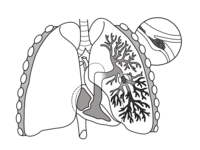
Photo from wikipedia
Abstract Funding Acknowledgements Type of funding sources: None. Introduction Left atrial cardiomyopathy (ACM) is invasively diagnosed by presence of low voltage substrate (LVS) in electro-anatomical mapping. ACM is associated with… Click to show full abstract
Abstract Funding Acknowledgements Type of funding sources: None. Introduction Left atrial cardiomyopathy (ACM) is invasively diagnosed by presence of low voltage substrate (LVS) in electro-anatomical mapping. ACM is associated with high (50%) AF recurrence rates after PVI, but also with increased risk for de-novo AF and ischemic stroke. Aims We establish and compare ACM-diagnosis based on 12-lead-ECG analysis, using (A) digital amplified p-wave analysis during SR versus (B) a neural network trained to diagnose ACM using automatically determined sinus-p-wave features (duration, morphology) in 12-lead-ECG as inputs. Methods Left atrial (LA) voltage mapping was acquired during SR in 270 AF (50% paroxysmal; 43% female; age: 64+/-11years) prior to PVI. ACM was defined as presence of left atrial LVS<0.5mV at >2cm2 during SR, and was detected in 95/270 (35.2%) of patients. P-wave-analysis was assessed for outcome prediction in a prospective cohort of persistent AF patients undergoing rhythm monitoring using 7-day Holter at 6 and 12 months post PVI-only approach. Results The duration of amplified sinus-p-wave (APWD) >151ms (left top panel) enabled to diagnose ACM with an AUC 0.87 (sensitivity: 78% and specificity: 76%, left bottom panel). The accuracy of the AI-neural-network-derived ECG-analysis (using automatically determined APWD and p-morphology criteria) for ACM diagnosis was: AUC 0.85, sensitivity 74%, specificity 78%, accuracy: 77% (see right panel top and bottom). Application of AI-derived ACM-diagnosis on a prospective cohort of persistent AF patients undergoing PVI-only approach (n=58) enabled arrhythmia outcome prediction: Patients with vs. without ACM (based on AI-derived p-wave-analysis) had significantly higher arrhythmia recurrences at 12 months following PVI (46% vs. 23%, p=0.017). Conclusion Both the measurement of the APWD and the automatic neural network-based p-wave-analysis enable diagnosis of individuals with left atrial cardiomyopathy with high accuracy in a large cohort of patients with paroxysmal and persistent AF. Diagnosis of ACM based on automatic neural-network-based P-wave analysis enables identification of patients at high risk for arrhythmia recurrence post PVI-only ablation approach.
Journal Title: Europace
Year Published: 2023
Link to full text (if available)
Share on Social Media: Sign Up to like & get
recommendations!